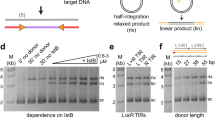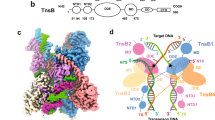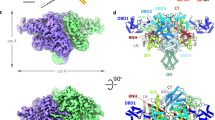Abstract
The integrase protein catalyzes the excision and integration of the Tn 916 conjugative transposon, a promiscuous genetic element that spreads antibiotic resistance in pathogenic bacteria. The solution structure of the N-terminal domain of the Tn916 integrase protein bound to its DNA-binding site within the transposon arm has been determined. The structure reveals an interesting mode of DNA recognition, in which the face of a three-stranded antiparallel β-sheet is positioned within the major groove. A comparison to the structure of the homing endonuclease I-PpoI–DNA complex suggests that the three-stranded sheet may represent a new DNA-binding motif whose residue composition and position within the major groove are varied to alter specificity. The structure also provides insights into the mechanism of conjugative transposition. The DNA in the complex is bent ˜35° and may, together with potential interactions between bound integrase proteins at directly repeated sites, significantly bend the arms of the transposon.
This is a preview of subscription content, access via your institution
Access options
Subscribe to this journal
Receive 12 print issues and online access
$189.00 per year
only $15.75 per issue
Buy this article
- Purchase on Springer Link
- Instant access to full article PDF
Prices may be subject to local taxes which are calculated during checkout





Similar content being viewed by others
References
Clewell, D.B., Flannagan, S.E. & Jaworski, D.D. Unconstrained bacterial promiscuity: the Tn916 –Tn1545 family of conjugative transposons. Trends Microbiol. 3, 229–236 ( 1995).
Scott, J.R. & Churchward, G. Conjugative transposition. Ann. Rev. Microbiol. 49, 367–397 (1995).
Salyers, A.A., Shoemaker, N.B., Stevens, A.M. & Li, L.Y. Conjugative transposons: an unusual and diverse set of integrated gene transfer elements. Microbiol. Rev. 59, 579– 590 (1995).
Poyart-Salmeron, C., Trieu-Cuot, P., Carlier, C. & Courvalin, P. Molecular characterization of two proteins involved in the excision of the conjugative transposon Tn1545. EMBO J. 8, 2425–2433 (1989).
Rudy, C., Taylor, K.L., Hinerfeld, D., Scott, J.R. & Churchward, G. Excision of a conjugative transposon in vitro by the Int and Xis proteins of Tn916. Nucleic Acids Res. 25, 4061–4066 (1997).
Jaworski, D.D., Flannagan, S.E. & Clewell, D.B. Analyses of traA, int-Tn, and xis-Tn mutations in the conjugative transposon Tn916 in Enterococcus faecalis. Plasmid 36, 201–208 ( 1996).
Esposito, D. & Scocca, J.J. The integrase family of tyrosine recombinases: evolution of a conserved active site domain. Nucleic Acid Res. 25, 3605–3614 (1997).
Argos, P. et al. The integrase family of site specific recombinases: regional similarities and global diversity. EMBO J. 5, 433–440 (1986).
Lu, F. & Churchward, G. Tn916 integrase contains two independent DNA binding domains that recognize different DNA sequences. EMBO J. 13, 1541–1548 (1994).
Landy, A. Dynamic, structural, and regulatory aspects of lambda site-specific integration. Ann. Rev. Biochem. 58, 913– 949 (1989).
Gou, F., Gopaul, D.N. & Van Duyne, G.D. Structure of Cre recombinase complexed with DNA in a site-specific recombination synapse. Nature 389, 40–46 (1997).
Hickman, A.B., Waninger, S., Scocca, J.J. & Dyda, F. Molecular organization in site-specific recombination: the catalytic domain of bacteriophage HP1 at 2.7Å resolution. Cell 89, 227 –237 (1997).
Kwon, H.J., Tirumalai, R., Landy, A. & Ellenberger, T. Flexibility in DNA recombination: structure of the lambda integrase catalytic core. Science 276, 126–131 ( 1997).
Subramanya, H.S. et al. Crystal structure of the site-specific recombinase, XerD. EMBO J. 16, 5178–5187 (1997).
Connolly, K.M., Wojciak, J.M. & Clubb, R.T. Site-specific DNA binding using a variation of the double stranded RNA binding motif. Nat. Struct. Biol. 5, 546–550 (1998).
Harrison, S.C. A structural taxonomy of DNA-binding domains. Nature 353, 715–719 (1991).
Luisi, B. in DNA–protein: structural interactions (ed. Lilley, D.M.) 1–48 (Oxford University Press, Oxford; 1995).
Pabo, C.O. & Sauer, R.T. Transcription factors—structural families and principles of DNA recognition. Annu. Rev. Biochem. 61, 1053 (1992).
Lavery, R. & Sklenar, H. The definition of generalized helicoidal parameters and of axis curvature for irregular nucleic acids. J. Biomol. Struct. Dynamics 6, 63– 91 (1988).
Thompson, J. & Landy, A. Empirical estimation of protein-Induced DNA bending angles: application to λ site-specific recombination complexes. Nucleic Acids Res. 16, 9687– 9705 (1988).
Somers, W.S. & Phillips, S.E.V. Crystal structure of the Met repressor–operator complex at 2.8 Å resolution reveals DNA recognition. Nature 359, 387–393 (1992).
Raumann, B.E., Rould, M.A., Pabo, C.O. & Sauer, R.T. DNA recognition by beta-sheets in the arc repressor-operator crystal structure. Nature 367, 754–757 ( 1994).
Flick, K.E., Jurica, M.S., Monnat, R.J. Jr & Stoddard, B.L. DNA binding and cleavage by the nuclear intron-encoded homing endonuclease I-Ppo I. Nature 394, 96–101 (1998).
Kim, S., Moitoso de Vargas, L., Nunes-Duby, S.E. & Landy, A. Mapping of a higher order protein–DNA complex: two kinds of long-range interactions in lambda attL. Cell 63, 773–781 (1990).
Han, Y.W., Gumport, R.I. & Gardner, J.F. Mapping the functional domains of the bacteriophage lambda integrase protein. J. Mol. Biol. 235, 908–925 (1994).
Bailey, M.F., Davidson, B.E., Haralambidis, J., Kwok, T. & Sawyer, W.H. Thermodynamics of the interaction of the Escherichia coli regulatory protein TyrR with DNA studied by fluorescence spectroscopy. Biochemistry 37, 7431–7443 (1998).
Grzesiek, S. & Bax, A. Improved 3D triple-resonance NMR techniques applied to a 31-kDa protein. J. Magn. Reson. 96, 432–440 (1992).
Wittekind, M. & Mueller, L. HNCACB, a high-sensitivity 3D NMR experiment to correlate amide-proton and nitrogen resonances with the alpha-carbon and beta-carbon resonances in proteins. J. Magn. Reson. 101, 201–205 (1993).
Grzesiek, S. & Bax, A. Correlating backbone amide and side chain resonances in larger proteins by multiple relayed triple resonance NMR. J. Am. Chem. Soc. 114, 6291– 6293 (1992).
Grzesiek, S., Anglister, J. & Bax, A. Correlation of backbone amide and aliphatic side-chain resonances in C-13/N-15-enriched proteins by isotropic mixing of C-13 magnetization. J. Magn. Reson. B 101, 114– 119 (1993).
Bax, A., Clore, G.M. & Gronenborn, A.M. 1H-1H Correlation via isotropic mixing of 13C magnetization, a new three-dimensional approach for assigning 1H and 13C spectra of 13C-enriched proteins. J. Magn. Reson. 88, 425–431 (1990).
Ikura, I., Kay, L.E. & Bax, A. Improved three-dimensional 1H-13C-1H correlation spectroscopy of a 13C-labeled protein using constant-time evolution. J. Biomol. NMR 1, 299– 304 (1991).
Marion, D. et al. Overcoming the overlap problem in the assignment of 1H NMR spectra of larger proteins by use of three-dimensional heteronuclear 1H-15N Hartmann–Hahn-multiple quantum coherence and nuclear Overhauser–multiple quantum coherence spectroscopy: application to interleukin 1 beta. Biochemistry 28, 6150–6156 (1989).
Vuister, G.W. & Bax, A. Quantitative J correlation—a new approach for measuring homonuclear 3-bond J(H(N)H(α)) coupling constants in N-15-enriched proteins. J. Am. Chem. Soc. 115, 7772–7777 (1993).
Archer, S.J., Ikura, M., Torchia, D.A. & Bax, A. An alternative 3D-NMR technique for correlating backbone N-15 with side chain H-beta-resonances in larger proteins. J Magn. Reson. 95, 636 –641 (1991).
Clore, G.M., Bax, A. & Gronenborn, G.M. Stereospecific assignment of beta-methylene protons in larger proteins using 3D 15N-separated Hartman–Hahn and 13-separated rotating frame Overhauser spectroscopy. J. Biomol. NMR 1, 13–22 ( 1991).
Fesik, S.W. & Zuiderweg, E.R.P. Heteronuclear three-dimensional NMR spectroscopy. a strategy for the simplification of homonuclear two-dimensional NMR spectra. J. Magn. Reson. 78, 588– 593 (1988).
Vuister, G.W. et al. Increased resolution and improved spectral quality in 4-dimensional C-13/C-13-separated HMQC-NOESY-HMQC spectra using pulsed field gradients. J. Magn. Reson. B 101, 210– 213 (1993).
Ikura, M. & Bax, A. Isotope-filtered 2D NMR of a protein peptide complex—study of a skeletal muscle myosin light chain kinase fragment bound to calmodulin. J. Am. Chem. Soc. 114 , 2433–2440 (1992).
Lee, W., Revington, M.J., Arrowsmith, C. & Kay, L.E. A Pulsed field gradient isotope-filtered 3D C-13 HMQC-NOESY experiment for extracting intermolecular NOE contacts in molecular complexes. FEBS Lett. 350, 87–90 ( 1994).
Piotto, M., Saudek, V. & Sklenar, V. Gradient-tailored excitation for single-quantum NMR spectroscopy of aqueous solutions. J. Biomol. NMR 2 , 661–665 (1992).
Delaglio, F. et al. NMRPipe—a multidimensional spectral processing system based on UNIX pipes. J. Biomol. NMR 6, 277 –293 (1995).
Garrett, D.S., Powers, R., Gronenborn, A.M. & Clore, G.M. A common sense approach to peak picking in two-, three-, and four-dimensional spectra using automated computer analysis of contour diagrams. J. Magn. Reson. 95, 214–220 (1991).
Brünger, A.T. X-PLOR (Version 3.1): a system for X-ray crystallography and NMR (Yale Univ. Press, New Haven, CT; 1993).
Nilges, M. A Calculation strategy for the structure determination of symmetric dimers by 1H NMR. Proteins 17, 297 –309 (1993).
Garrett, D.S. The impact of direct refinement against three-bond HN-CαH coupling constants on protein determination by NMR. J. Magn. Reson. B 104, 99–103 (1994).
Groneborn, A.M., & Clore, G.M. Analysis of the relative contributions of the nuclear Overhauser interproton distance restraints and the empirical energy function in the calculation of oligonucleotide structures using restrained molecular dynamics. Biochemistry 28 , 5978–5984 (1989).
Nilges, M., Clore, G.M. & Gronenborn, A.M. Determination of three-dimensional structures of proteins from interproton distance data by hybrid distance geometry-dynamic simulated annealing. FEBS Lett. 229, 129– 136 (1988).
Koradi, R., Billeter, M. & Wuthrich, K. MOLMOL: a program for display and analysis of macromolecular structures. J. Mol. Graph. 14, 51– 55 (1996).
Kamada, K., Horiuchi, T., Ohsumi, K., Shimaoto, N. & Morikawa, K. Structure of a replication-terminator protein complexed with DNA. Nature 383, 598– 603 (1996).
Kabsch, W. & Sander, C. Dictionary of protein secondary structure: pattern recognition of hydrogen-bonded and geometrical features. Biopolymers 22, 257–2637 (1983).
Acknowledgements
This work was supported by grants from the U.S. Department of Energy and the National Institutes of Health. We thank F. Delaglio and D. Garrett for software support; T. Dieckmann, M. Grzeskowiak and M. Phillips for technical support; F. Allain, J. Bowie, D. Eisenberg, and C. Kim for useful discussions. We also thank B. Stoddard for the coordinates of the I-PpoI DNA complex.
Author information
Authors and Affiliations
Corresponding author
Rights and permissions
About this article
Cite this article
Wojciak, J., Connolly, K. & Clubb, R. NMR structure of the Tn916 integrase–DNA complex. Nat Struct Mol Biol 6, 366–373 (1999). https://doi.org/10.1038/7603
Received:
Accepted:
Issue Date:
DOI: https://doi.org/10.1038/7603
This article is cited by
-
THAP proteins target specific DNA sites through bipartite recognition of adjacent major and minor grooves
Nature Structural & Molecular Biology (2010)



